American photographer George Hurrell (1904-1992) was a major contributor to the image of glamour presented by Hollywood during the 1930s and 1940s. Always an innovator, he invented the boom light and developed several - now standard - lighting techniques. Hurrell’s signature use of precision lighting, spotlights, shadows, and hand-retouching on the negatives produced romantic portraits that became his trademark style. His influential look became known as the 'Hurrell style'.
Image may be NSFW.
Clik here to view.
Joan Crawford. Vintage postcard. Photo: George Hurrell, 1932.
Image may be NSFW.
Clik here to view.
Myna Loy. French postcard by P.C., Paris, no. 38. Photo: George Hurrell, 1932 / MGM (Metro-Goldwyn-Mayer).
Image may be NSFW.
Clik here to view.
Ann Sheridan. French postcard by Editions P.I., no. 257. Photo: George Hurrell / Warner Bros.
Image may be NSFW.
Clik here to view.
French postcard by Editions P.I., Paris, no. 408, 1952. Photo: George Hurrell / Paramount. Veronica Lake in This Gun for Hire (Frank Tuttle, 1942).
Image may be NSFW.
Clik here to view.
Vintage postcard. Photo: George Hurrell. Jane Russell in The Outlaw (Howard Hughes, 1943).
George Edward Hurrell was born in 1904 in Cincinnati, Ohio, in a large Catholic family. His parents, Edward Hurrell and his wife Anna Mary Eble had five sons and one daughter. His father worked in the shoe business. In 1909, the family moved to Chicago to open their own shoe factory.
An altar boy during his youth, upon reflecting on what his own career path might be, a young George Hurrell initially signed up at the Quigley Seminary in Chicago to become a priest but decided to go to art school instead. Following graduation from high school, he enrolled at the Chicago Art Institute and later took night school classes at the Academy of Fine Arts studying painting.
Hurrell became acquainted with the camera while in art school because students typically photographed various indoor and outdoor scenes to use as a reference while painting. In 1923, the famous Chicago portrait photographer Eugene Hutchinson asked Hurrell to join him as an assistant in his studio in the Fine Arts Building on Michigan Avenue. This was the beginning of Hurrell’s interest in studio portrait work.
In 1925, while still attending the Art Institute, Hurrell heard that famed landscape painter, Edgar Alwyn Payne, an alum of the Art Institute, would be giving a lecture at the school. Hurrell attended the lecture, and afterward Payne viewed the student’s work. Payne was particularly impressed with Hurrell's’ experimental painting style, and also liked a recently completed landscape painting. Payne invited him to come with him to Laguna Beach, which was then a famous art colony. Hurrell eagerly accepted the opportunity and celebrated his 21st birthday at Laguna Beach.
Through the intervention of Payne and his wife, Elsie Payne, Hurrell moved into a vacant but completely furnished hillside shack owned by silent film director, Mal St. Clair, and lived rent-free in exchange for keeping an eye on the place. Hurrell studied painting with William Wendt, who became Hurrell’s mentor and closest friend. Hurrell focused on painting but also conducted photographic experiments with sunlight with his second-hand view camera from Chicago. Hurrell soon discovered that taking pictures of local artists and the social scene paid much more readily than painting.
In 1925, he met Florence Leontine Lowe Barnes (the later Pancho Barnes), three years his senior and very rich. The two became fast friends. Hurrell became a frequent pool-side guest at Dos Rocas, Barnes’ 40-acre estate on the bluffs of Laguna Beach. There Hurrell met her society friends, including her best friend Ramon Novarro, at the time the most famous and the highest-paid movie star in the world.
George Hurrell moved to Los Angeles and opened his first photography studio at a live-work artists loft at LaFayette Park Place. His friend Leon Gordon arranged for Hurrell to meet Edward Steichen and he was asked to develop and print some negatives. When Steichen saw the results, he encouraged Hurrell to pursue his photographic career.
In 1929, Ramon Novarro, who was of Mexican heritage, was worried that he might not make the transition to sound film because of his slight accent. However, he had a wonderful operatic voice and was thinking about an opera career. He needed some publicity photos for which he could not use the usual Hollywood photographers. At Pancho Barnes’s urging, Novarro had a series of photographs taken by George Hurrell.
Novarro showed the photos that Hurrell took of him to his best friend back at MGM, Norma Shearer who was having problems of a different sort. She was married to the head of production at MGM, Irving Thalberg. Norma wanted to play a sexy vamp in the film The Divorcee (Robert Z. Leonard, 1930), but, up until this time, she was known for her 'all-American girl next door' image. When she showed the script to her husband, he replied “Honey, I don’t think this part is for you. You are not sexy in THAT way.”
After seeing Hurrell's photos of Novarro, she decided to have some photos taken by Hurrell so that she could convince her husband that she was indeed sexy in THAT way. Hurrell's photos convinced her husband, Norma Shearer got the film role and their marriage improved. Shearer won the Academy Award for Best Actress as a result of her portrayal in that film, and Hurrell was offered a job as a portrait photographer at MGM. At first, he hesitated, but when in late October 1929 the stock market crashed, Pancho encouraged her friend to take the job and flew Hurrell from her home’s private landing strip in Laguna Beach to the MGM meeting in her Travel Air biplane, and George famously wing-walked on her plane on the way up. In Hollywood, Hurrell accepted the job.
Image may be NSFW.
Clik here to view.![Greta Garbo]()
German postcard by Ross Verlag, no. 4696/3, 1929-1930. Photo: George Hurrell / Metro-Goldwyn-Mayer. Greta Garbo in Romance (Clarence Brown, 1930).
Image may be NSFW.
Clik here to view.![Greta Garbo]()
German postcard by Ross Verlag, no. 6215/1, 1931-1932. Photo: George Hurrell / MGM (Metro-Goldwyn-Mayer). Greta Garbo in an over-the-top dress by Adrian in Romance (Clarence Brown, 1930). Set by Cedric Gibbons.
Image may be NSFW.
Clik here to view.![Greta Garbo in Romance (1930)]()
German postcard by Ross Verlag, no. 6215/2, 1931-1932. Photo: George Hurrell / MGM (Metro-Goldwyn-Mayer). Greta Garbo in Romance (Clarence Brown, 1930).
Image may be NSFW.
Clik here to view.![Myrna Loy]()
Myrna Loy. French postcard by Editions Chantal (EC), no. 40. Photo: George Hurrell / MGM (Metro-Goldwyn-Mayer), 1932.
Image may be NSFW.
Clik here to view.![Joan Crawford]()
Joan Crawford. Dutch postcard by H.A.T.E., Rotterdam, no. 445, sent by mail in the Netherlands in 1934. Photo: George Hurrell / MGM (Metro-Goldwyn-Mayer).
On 1 January 1930, George Hurrell began to work as the head portrait photographer for MGM Studios. His first assignment was to shoot starlet Harriet Lake, who later became known as Ann Sothern. His first Hollywood star was Lon Chaney. At this time, Hurrell developed his superb talent for entertaining and relaxing the stars with jazz music, acrobatics, and other activities during their day-long photo sessions. Among the MGM stars regularly photographed by him during these years were silent screen star Dorothy Jordan, Myrna Loy, Robert Montgomery, Jean Harlow, Joan Crawford, Clark Gable, Rosalind Russell, Marion Davies, Jeanette MacDonald, Lupe Velez, Anna May Wong, and Carole Lombard.
His striking black-and-white images were used extensively in the marketing of these stars. Hurrell also photographed Greta Garbo at a session to produce promotional material for Romance. The session didn't go well and she never used him again. In 1932, he left MGM, after a blow-up with Howard Strickling, the head of publicity for Metro-Goldwyn-Mayer, for photographing non-MGM stars on the weekend. In October 1932 Hurrell opened a photographic studio at Sunset Blvd., where he shot freelance for all the major studios, including MGM, till 1938.
In 1938, he closed the Hurrell Photography studio on Sunset Blvd and accepted an exclusive contract with Warner Bros. as a head portrait photographer. He photographed among others Bette Davis, Ann Sheridan, Errol Flynn, Olivia de Havilland, Ida Lupino, Alexis Smith, Lauren Bacall, Humphrey Bogart, and James Cagney. He also became a regular contributor to Esquire magazine. As a result of Warner Bros. publicity and his monthly exposure in Esquire, Hurrell became a household name. Several magazine articles appeared featuring stories about George Hurrell and his photography. In 1939, he met and married his first wife, Katherine Cuddy, who was a beauty contest winner from Seattle. They divorced in 1942.
In 1940, he resigned at Warner Bros. Studios and in 1941 he completed the build-out of his custom photography studio at 333 Rodeo Drive, Beverly Hills. Greta Garbo was his landlady. He also started accepting assignments in New York, leasing studio space for several months at the Waldorf Astoria in New York City.
In 1942 and 1943, he was a gallery photographer for Columbia Studios. Here his photographs were used to help the studio build the career of Rita Hayworth. In November 1942, Hurrell was drafted, but with the help of Pancho Barnes, who was close friends with General Hap Arnold, he was assigned to the First Motion Picture Unit of the U.S. Army Air Force in Culver City, California. He made training films at Hal Roach Studios in Culver City and later became a staff photographer at the Pentagon. In 1943, he was discharged from armed services.
He re-opened his Rodeo Drive studio in Beverly Hills in October. He also married his second wife, Phyllis Bounds, a niece of Walt Disney. They have three children, Clancy, Victoria, and Alexandra. After the war, he started commercial work for J. Walter Thompson Agency in advertising. He shot several advertising accounts using the experimental and immensely expensive tri-color carbro color process, developed and printed by Paul Outerbridge. Hurrell and second wife, Phyllis, divorced in 1954.
In 1955, he returned to Beverly Hills and reopened the Rodeo Drive studio. His old style of glamour had fallen from favour. Where he had worked hard to create an idealised image of his subjects, the new style of Hollywood glamour was more earthy and gritty, and for the first time in his career, Hurrell's style was not in demand. Then he met his soul mate and third wife, Betty Willis. They had three children, George Jr., Daphne, and Michael. In 1958, he formed a partnership with Walt Disney in Hollywood and created Hurrell Productions, a production company for educational films and TV commercials, which was housed on The Walt Disney Studios lot in Burbank. He served as a producer, director, and occasionally as a cinematographer.
He disbanded Hurrell Productions in 1960 and began to work as a stills photographer for various TV shows using 35mm format cameras. Hurrell shot for Gunsmoke and the Danny Thomas Show among others. In 1965, his photography was included in the exhibition, 'Glamour Portraits' at the Museum of Modern Art in New York.
From 1969 till 1976, he worked as a freelance stills photographer on various films including Planet Of The Apes (Franklin J. Schaffner, 1968), Butch Cassidy and the Sundance Kid (George Roy Hill, 1969), The Towering Inferno (John Guillermin, 1974), and All the President’s Men (Alan J. Pakula, 1976). After 1970, his most prominent work was as a photographer for album covers. He shot the cover photos for Cass Elliot's self-titled album (1972), Tom Waits''Foreign Affairs' (1977), Fleetwood Mac's 'Mirage' (1982), Queen's 'The Works' (1984), Midge Ure's 'The Gift' (1985) and Paul McCartney's 'Press to Play' (1986).
From 1976 on, he was semi-retired but accepted occasional portrait assignments that keep him active fos such clients as Liza Minnelli, Paul Newman, and Robert Redford. His work was exhibited in 'Dream For Sale' (1976) at the Municipal Art Museum, Los Angeles. The book,'The Hurrell Style' was published by the John Day Company.
In 1980, Hurrell started to set auction records for his vintage photographs from the 1930s. 'Hurrell Portfolio I, limited editions' was published. Prints from the edition quickly realised $1,100 – $1,300 at various auction houses. Hurrell's work was also featured in the book by John Kobal, 'The Art Of The Great Hollywood Photographers, 1925-1940'. A circa 1930, 9 x 12” print of Ramon Novarro as the 'New Orpheus' is auctioned for $9,000 at Christie’s East, N.Y, setting a record price for a portrait by a living photographer in 1981. The photograph was accepted into the permanent collection of the Metropolitan Museum, New York.
His friend and fellow photographer Helmut Newton came the idea to invite George Hurrell to photograph the Paris collections for the March 1983 edition of Vogue Paris. Hurrell shot 40 pages in black and white and color within the tight 10-day schedule. Hurrell’s work was featured in the exhibition 'The Hollywood Portrait Photographers, 1921-1941' at the Museum of Modern Art, New York.
He continued with freelance portraiture for magazines photographing Farrah Fawcett, Bette Midler, Brooke Shields, John Travolta, and other New Hollywood stars. His work was exhibited in the show 'The Art of the Great Hollywood Photographers' (1983) at the National Portrait Gallery in Washington, D.C. The following year his photography was included in the Smithsonian‘s touring exhibition 'The Great Hollywood Portrait Photographers'.
In 1984, he also shot Joan Collins nude for Playboy magazine. His 1930s photographs appeared in the exhibition, 'Masters of Starlight’ at the Los Angeles County Museum of Art. And in 1991, 'The Book of Stars' by George Hurrell was published by Schirmer Art Books, featuring photographs from 1928 till 1990.
In 1992, George Hurrell passed away in Cedars Sinai Hospital, from his long-standing problems with bladder cancer. He was 87. He had just finished narration on 'Legends In Light' (1992), a TBS documentary about his life. Since his death, his works have continued to appreciate in value and examples of his artistic output can be found in the permanent collections of numerous museums around the world.
Image may be NSFW.
Clik here to view.![Joan Crawford]()
Joan Crawford. Dutch postcard by JosPe, no. 221. Photo: George Hurrell / MGM (Metro-Goldwyn-Mayer).
Image may be NSFW.
Clik here to view.![Joan Crawford and Franchot Tone in Dancing Lady (1933)]()
Dutch postcard, no. 571. Photo: George Hurrell / MGM (Metro-Goldwyn-Mayer). Joan Crawford and Franchot Tone in Dancing Lady (Robert Z. Leonard, 1933).
Image may be NSFW.
Clik here to view.![Joan Crawford and Clark Gable in Dancing Lady (1933)]()
Dutch postcard, no. 596. Photo: George Hurrell / MGM (Metro-Goldwyn-Mayer). Joan Crawford and Clark Gable in Dancing Lady (Robert Z. Leonard, 1933).
Image may be NSFW.
Clik here to view.![Charles Boyer]()
Charles Boyer. British postcard in the Picturegoer Series, London, no. 1258. Photo: George Hurrell / RKO Radio.
Image may be NSFW.
Clik here to view.![Spencer Tracy and Joan Crawford in Mannequin (1937)]()
British postcard in the Film Partners Series, London, no. P 230. Photo: George Hurrell / MGM (Metro-Goldwyn-Mayer). Spencer Tracy and Joan Crawford in Mannequin (Frank Borzage, 1937).
Image may be NSFW.
Clik here to view.![Lupe Velez]()
Lupe Velez. Dutch postcard by Smeets & Schippers, Amsterdam. Photo: George Hurrell / MGM (Metro-Goldwyn-Mayer).
Image may be NSFW.
Clik here to view.![Veronica Lake]()
Big Belgian card by Chocolaterie Clovis, Pepinster. Photo: George Hurrell / Paramount. Veronica Lake in This Gun for Hire (Frank Tuttle, 1942).
Sources: George Hurrell.com, Walt Disney.org, and Wikipedia.
Image may be NSFW.
Clik here to view.
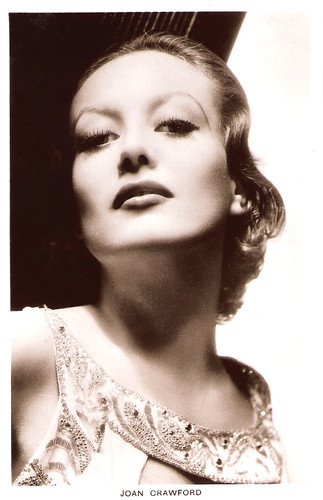
Joan Crawford. Vintage postcard. Photo: George Hurrell, 1932.
Image may be NSFW.
Clik here to view.
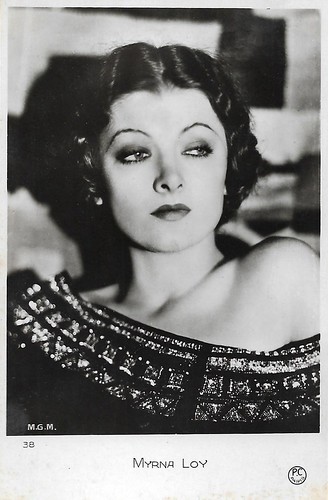
Myna Loy. French postcard by P.C., Paris, no. 38. Photo: George Hurrell, 1932 / MGM (Metro-Goldwyn-Mayer).
Image may be NSFW.
Clik here to view.

Ann Sheridan. French postcard by Editions P.I., no. 257. Photo: George Hurrell / Warner Bros.
Image may be NSFW.
Clik here to view.

French postcard by Editions P.I., Paris, no. 408, 1952. Photo: George Hurrell / Paramount. Veronica Lake in This Gun for Hire (Frank Tuttle, 1942).
Image may be NSFW.
Clik here to view.

Vintage postcard. Photo: George Hurrell. Jane Russell in The Outlaw (Howard Hughes, 1943).
Convincing Irving Thalberg that his wife could be sexy in THAT way
George Edward Hurrell was born in 1904 in Cincinnati, Ohio, in a large Catholic family. His parents, Edward Hurrell and his wife Anna Mary Eble had five sons and one daughter. His father worked in the shoe business. In 1909, the family moved to Chicago to open their own shoe factory.
An altar boy during his youth, upon reflecting on what his own career path might be, a young George Hurrell initially signed up at the Quigley Seminary in Chicago to become a priest but decided to go to art school instead. Following graduation from high school, he enrolled at the Chicago Art Institute and later took night school classes at the Academy of Fine Arts studying painting.
Hurrell became acquainted with the camera while in art school because students typically photographed various indoor and outdoor scenes to use as a reference while painting. In 1923, the famous Chicago portrait photographer Eugene Hutchinson asked Hurrell to join him as an assistant in his studio in the Fine Arts Building on Michigan Avenue. This was the beginning of Hurrell’s interest in studio portrait work.
In 1925, while still attending the Art Institute, Hurrell heard that famed landscape painter, Edgar Alwyn Payne, an alum of the Art Institute, would be giving a lecture at the school. Hurrell attended the lecture, and afterward Payne viewed the student’s work. Payne was particularly impressed with Hurrell's’ experimental painting style, and also liked a recently completed landscape painting. Payne invited him to come with him to Laguna Beach, which was then a famous art colony. Hurrell eagerly accepted the opportunity and celebrated his 21st birthday at Laguna Beach.
Through the intervention of Payne and his wife, Elsie Payne, Hurrell moved into a vacant but completely furnished hillside shack owned by silent film director, Mal St. Clair, and lived rent-free in exchange for keeping an eye on the place. Hurrell studied painting with William Wendt, who became Hurrell’s mentor and closest friend. Hurrell focused on painting but also conducted photographic experiments with sunlight with his second-hand view camera from Chicago. Hurrell soon discovered that taking pictures of local artists and the social scene paid much more readily than painting.
In 1925, he met Florence Leontine Lowe Barnes (the later Pancho Barnes), three years his senior and very rich. The two became fast friends. Hurrell became a frequent pool-side guest at Dos Rocas, Barnes’ 40-acre estate on the bluffs of Laguna Beach. There Hurrell met her society friends, including her best friend Ramon Novarro, at the time the most famous and the highest-paid movie star in the world.
George Hurrell moved to Los Angeles and opened his first photography studio at a live-work artists loft at LaFayette Park Place. His friend Leon Gordon arranged for Hurrell to meet Edward Steichen and he was asked to develop and print some negatives. When Steichen saw the results, he encouraged Hurrell to pursue his photographic career.
In 1929, Ramon Novarro, who was of Mexican heritage, was worried that he might not make the transition to sound film because of his slight accent. However, he had a wonderful operatic voice and was thinking about an opera career. He needed some publicity photos for which he could not use the usual Hollywood photographers. At Pancho Barnes’s urging, Novarro had a series of photographs taken by George Hurrell.
Novarro showed the photos that Hurrell took of him to his best friend back at MGM, Norma Shearer who was having problems of a different sort. She was married to the head of production at MGM, Irving Thalberg. Norma wanted to play a sexy vamp in the film The Divorcee (Robert Z. Leonard, 1930), but, up until this time, she was known for her 'all-American girl next door' image. When she showed the script to her husband, he replied “Honey, I don’t think this part is for you. You are not sexy in THAT way.”
After seeing Hurrell's photos of Novarro, she decided to have some photos taken by Hurrell so that she could convince her husband that she was indeed sexy in THAT way. Hurrell's photos convinced her husband, Norma Shearer got the film role and their marriage improved. Shearer won the Academy Award for Best Actress as a result of her portrayal in that film, and Hurrell was offered a job as a portrait photographer at MGM. At first, he hesitated, but when in late October 1929 the stock market crashed, Pancho encouraged her friend to take the job and flew Hurrell from her home’s private landing strip in Laguna Beach to the MGM meeting in her Travel Air biplane, and George famously wing-walked on her plane on the way up. In Hollywood, Hurrell accepted the job.
Image may be NSFW.
Clik here to view.

German postcard by Ross Verlag, no. 4696/3, 1929-1930. Photo: George Hurrell / Metro-Goldwyn-Mayer. Greta Garbo in Romance (Clarence Brown, 1930).
Image may be NSFW.
Clik here to view.
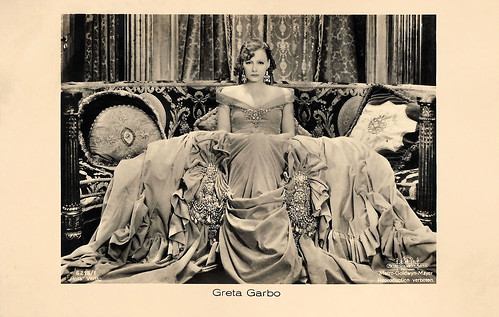
German postcard by Ross Verlag, no. 6215/1, 1931-1932. Photo: George Hurrell / MGM (Metro-Goldwyn-Mayer). Greta Garbo in an over-the-top dress by Adrian in Romance (Clarence Brown, 1930). Set by Cedric Gibbons.
Image may be NSFW.
Clik here to view.
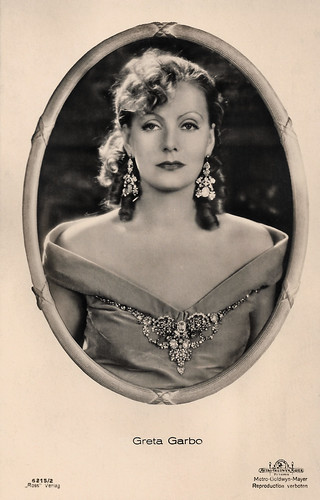
German postcard by Ross Verlag, no. 6215/2, 1931-1932. Photo: George Hurrell / MGM (Metro-Goldwyn-Mayer). Greta Garbo in Romance (Clarence Brown, 1930).
Image may be NSFW.
Clik here to view.
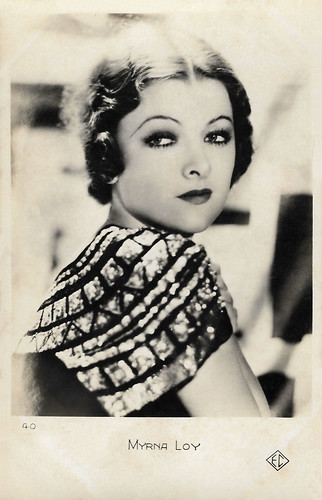
Myrna Loy. French postcard by Editions Chantal (EC), no. 40. Photo: George Hurrell / MGM (Metro-Goldwyn-Mayer), 1932.
Image may be NSFW.
Clik here to view.
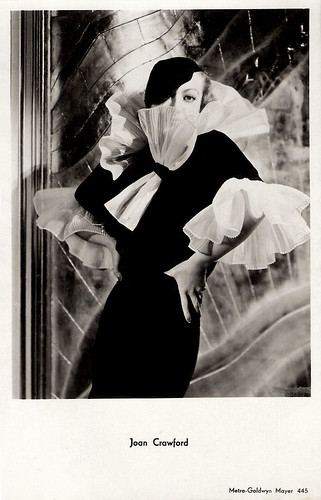
Joan Crawford. Dutch postcard by H.A.T.E., Rotterdam, no. 445, sent by mail in the Netherlands in 1934. Photo: George Hurrell / MGM (Metro-Goldwyn-Mayer).
The session with Greta Garbo that did not go well
On 1 January 1930, George Hurrell began to work as the head portrait photographer for MGM Studios. His first assignment was to shoot starlet Harriet Lake, who later became known as Ann Sothern. His first Hollywood star was Lon Chaney. At this time, Hurrell developed his superb talent for entertaining and relaxing the stars with jazz music, acrobatics, and other activities during their day-long photo sessions. Among the MGM stars regularly photographed by him during these years were silent screen star Dorothy Jordan, Myrna Loy, Robert Montgomery, Jean Harlow, Joan Crawford, Clark Gable, Rosalind Russell, Marion Davies, Jeanette MacDonald, Lupe Velez, Anna May Wong, and Carole Lombard.
His striking black-and-white images were used extensively in the marketing of these stars. Hurrell also photographed Greta Garbo at a session to produce promotional material for Romance. The session didn't go well and she never used him again. In 1932, he left MGM, after a blow-up with Howard Strickling, the head of publicity for Metro-Goldwyn-Mayer, for photographing non-MGM stars on the weekend. In October 1932 Hurrell opened a photographic studio at Sunset Blvd., where he shot freelance for all the major studios, including MGM, till 1938.
In 1938, he closed the Hurrell Photography studio on Sunset Blvd and accepted an exclusive contract with Warner Bros. as a head portrait photographer. He photographed among others Bette Davis, Ann Sheridan, Errol Flynn, Olivia de Havilland, Ida Lupino, Alexis Smith, Lauren Bacall, Humphrey Bogart, and James Cagney. He also became a regular contributor to Esquire magazine. As a result of Warner Bros. publicity and his monthly exposure in Esquire, Hurrell became a household name. Several magazine articles appeared featuring stories about George Hurrell and his photography. In 1939, he met and married his first wife, Katherine Cuddy, who was a beauty contest winner from Seattle. They divorced in 1942.
In 1940, he resigned at Warner Bros. Studios and in 1941 he completed the build-out of his custom photography studio at 333 Rodeo Drive, Beverly Hills. Greta Garbo was his landlady. He also started accepting assignments in New York, leasing studio space for several months at the Waldorf Astoria in New York City.
In 1942 and 1943, he was a gallery photographer for Columbia Studios. Here his photographs were used to help the studio build the career of Rita Hayworth. In November 1942, Hurrell was drafted, but with the help of Pancho Barnes, who was close friends with General Hap Arnold, he was assigned to the First Motion Picture Unit of the U.S. Army Air Force in Culver City, California. He made training films at Hal Roach Studios in Culver City and later became a staff photographer at the Pentagon. In 1943, he was discharged from armed services.
He re-opened his Rodeo Drive studio in Beverly Hills in October. He also married his second wife, Phyllis Bounds, a niece of Walt Disney. They have three children, Clancy, Victoria, and Alexandra. After the war, he started commercial work for J. Walter Thompson Agency in advertising. He shot several advertising accounts using the experimental and immensely expensive tri-color carbro color process, developed and printed by Paul Outerbridge. Hurrell and second wife, Phyllis, divorced in 1954.
In 1955, he returned to Beverly Hills and reopened the Rodeo Drive studio. His old style of glamour had fallen from favour. Where he had worked hard to create an idealised image of his subjects, the new style of Hollywood glamour was more earthy and gritty, and for the first time in his career, Hurrell's style was not in demand. Then he met his soul mate and third wife, Betty Willis. They had three children, George Jr., Daphne, and Michael. In 1958, he formed a partnership with Walt Disney in Hollywood and created Hurrell Productions, a production company for educational films and TV commercials, which was housed on The Walt Disney Studios lot in Burbank. He served as a producer, director, and occasionally as a cinematographer.
He disbanded Hurrell Productions in 1960 and began to work as a stills photographer for various TV shows using 35mm format cameras. Hurrell shot for Gunsmoke and the Danny Thomas Show among others. In 1965, his photography was included in the exhibition, 'Glamour Portraits' at the Museum of Modern Art in New York.
From 1969 till 1976, he worked as a freelance stills photographer on various films including Planet Of The Apes (Franklin J. Schaffner, 1968), Butch Cassidy and the Sundance Kid (George Roy Hill, 1969), The Towering Inferno (John Guillermin, 1974), and All the President’s Men (Alan J. Pakula, 1976). After 1970, his most prominent work was as a photographer for album covers. He shot the cover photos for Cass Elliot's self-titled album (1972), Tom Waits''Foreign Affairs' (1977), Fleetwood Mac's 'Mirage' (1982), Queen's 'The Works' (1984), Midge Ure's 'The Gift' (1985) and Paul McCartney's 'Press to Play' (1986).
From 1976 on, he was semi-retired but accepted occasional portrait assignments that keep him active fos such clients as Liza Minnelli, Paul Newman, and Robert Redford. His work was exhibited in 'Dream For Sale' (1976) at the Municipal Art Museum, Los Angeles. The book,'The Hurrell Style' was published by the John Day Company.
In 1980, Hurrell started to set auction records for his vintage photographs from the 1930s. 'Hurrell Portfolio I, limited editions' was published. Prints from the edition quickly realised $1,100 – $1,300 at various auction houses. Hurrell's work was also featured in the book by John Kobal, 'The Art Of The Great Hollywood Photographers, 1925-1940'. A circa 1930, 9 x 12” print of Ramon Novarro as the 'New Orpheus' is auctioned for $9,000 at Christie’s East, N.Y, setting a record price for a portrait by a living photographer in 1981. The photograph was accepted into the permanent collection of the Metropolitan Museum, New York.
His friend and fellow photographer Helmut Newton came the idea to invite George Hurrell to photograph the Paris collections for the March 1983 edition of Vogue Paris. Hurrell shot 40 pages in black and white and color within the tight 10-day schedule. Hurrell’s work was featured in the exhibition 'The Hollywood Portrait Photographers, 1921-1941' at the Museum of Modern Art, New York.
He continued with freelance portraiture for magazines photographing Farrah Fawcett, Bette Midler, Brooke Shields, John Travolta, and other New Hollywood stars. His work was exhibited in the show 'The Art of the Great Hollywood Photographers' (1983) at the National Portrait Gallery in Washington, D.C. The following year his photography was included in the Smithsonian‘s touring exhibition 'The Great Hollywood Portrait Photographers'.
In 1984, he also shot Joan Collins nude for Playboy magazine. His 1930s photographs appeared in the exhibition, 'Masters of Starlight’ at the Los Angeles County Museum of Art. And in 1991, 'The Book of Stars' by George Hurrell was published by Schirmer Art Books, featuring photographs from 1928 till 1990.
In 1992, George Hurrell passed away in Cedars Sinai Hospital, from his long-standing problems with bladder cancer. He was 87. He had just finished narration on 'Legends In Light' (1992), a TBS documentary about his life. Since his death, his works have continued to appreciate in value and examples of his artistic output can be found in the permanent collections of numerous museums around the world.
Image may be NSFW.
Clik here to view.
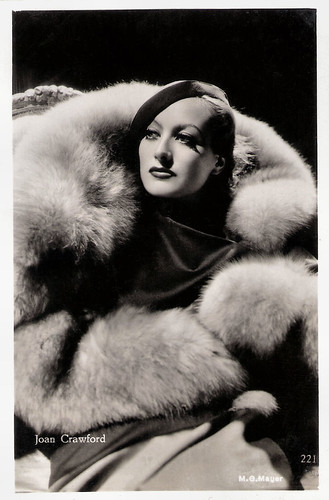
Joan Crawford. Dutch postcard by JosPe, no. 221. Photo: George Hurrell / MGM (Metro-Goldwyn-Mayer).
Image may be NSFW.
Clik here to view.

Dutch postcard, no. 571. Photo: George Hurrell / MGM (Metro-Goldwyn-Mayer). Joan Crawford and Franchot Tone in Dancing Lady (Robert Z. Leonard, 1933).
Image may be NSFW.
Clik here to view.

Dutch postcard, no. 596. Photo: George Hurrell / MGM (Metro-Goldwyn-Mayer). Joan Crawford and Clark Gable in Dancing Lady (Robert Z. Leonard, 1933).
Image may be NSFW.
Clik here to view.

Charles Boyer. British postcard in the Picturegoer Series, London, no. 1258. Photo: George Hurrell / RKO Radio.
Image may be NSFW.
Clik here to view.

British postcard in the Film Partners Series, London, no. P 230. Photo: George Hurrell / MGM (Metro-Goldwyn-Mayer). Spencer Tracy and Joan Crawford in Mannequin (Frank Borzage, 1937).
Image may be NSFW.
Clik here to view.

Lupe Velez. Dutch postcard by Smeets & Schippers, Amsterdam. Photo: George Hurrell / MGM (Metro-Goldwyn-Mayer).
Image may be NSFW.
Clik here to view.
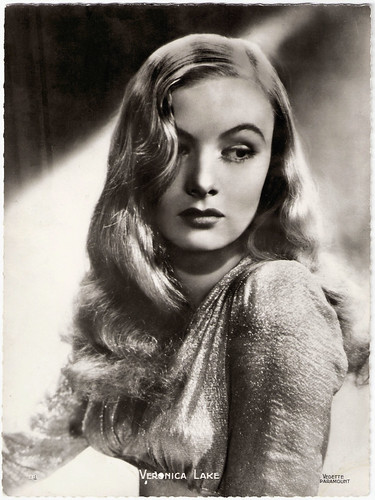
Big Belgian card by Chocolaterie Clovis, Pepinster. Photo: George Hurrell / Paramount. Veronica Lake in This Gun for Hire (Frank Tuttle, 1942).
Sources: George Hurrell.com, Walt Disney.org, and Wikipedia.